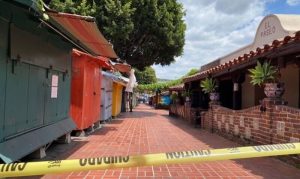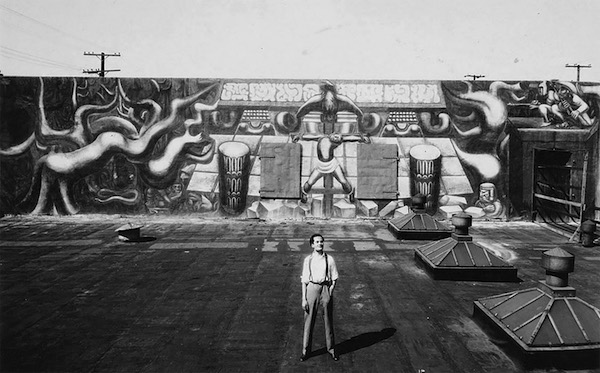Tucked between two of the quaint brick and wooden structures comprising the colonial phantasmagoria that is LA’s Olvera Street, is a rooftop mural painted by the famed Mexican activist, Marxist organizer and painter, David Alfaro Siqueiros. The passion project of 1920s preservationist Christine Sterling, Olvera Street represented Southern California’s new, much whiter population’s fantastical vision of “Mexican History.” Known today as the “original gentrifier,” Sterling partnered with the notorious Los Angeles Times editor and real-estate mogul Harry Chandler to help construct this vision at the center of downtown. With Chandler’s financial backing, Sterling revamped the street beside the Avila Adobe—a vestige from the Mission era of Spanish colonization—to create a simulacrum of a Mexican marketplace. Unencumbered by the long history of Spanish and Anglo colonization and genocide that had displaced so many indigenous Califorinian peoples, today’s Olvera Street remains true to Sterling and Chandler’s 1930s vision; a romanticized historical proxy that protects its visitors from acknowledging America’s genocidal past.
Soon after Olvera Street’s opening in 1930, Siquieros was commissioned to help complete Sterling’s spurious vision. Despite Siquieros’ renown as a leader of a political and cultural revolution in Mexico, founded in a rejection of U.S. Imperialism, the financial interests looking to trade in on Siqueiros’ notoriety and cultural capital were shocked and dismayed when he unveiled his completed mural, América Tropical: Oprimida y Destrozada por los Imperialismos (Tropical America: Oppressed and Destroyed by Imperialism, 1932). A striking homage to the indigenous culture and labor upon which the affluence and power of the emerging 20th-century Los Angeles metropolis was built, Siqueiros’ painting stands in stark contrast to its idyllic surround.

Olvera Street during COVID-19 pandemic, 2020.
The mural depicts thick, nodular tree roots in brassy, oak-hued tendrils that dominate the pictorial frame in a rhizomatic field, enwrapping the viewer into its narrative of indigenous exploitation. The roots serve as a curvaceous canopy against which a sturdy Aztec pyramid is juxtaposed. The figure of an indigenous man is offered up in the center of the frame. The man is tightly bound to a wooden doublecross, his head hanging askew in tragic lifelessness. Perched atop the man, a vivid, yellow-golden eagle is perched with wings spread and beak agape, as if crying out in victorious joy; lording over its bounty of prey.
Though today the once vibrant mural has faded, this was part of Siqueiros’ original intent. Siqueiros insisted the mural never be repainted or restored to its original colorful state. According to him: the mural’s eventual decay reflects its boundedness to its environmental milieu, and to time as history. Unfortunately, the mural was never given the chance to age naturally as it was swiftly censored and painted over in 1932. Since that time, renewed attention brought about by Chicano civil rights activists working in the 1960s and 1970s inaugurated a restoration project. In a collaboration with the Getty Conservation Institute and “The City” (El Pueblo de Los Angeles Historical Monument), the mural restoration was finally completed in 2012 and can be seen for free at the American Tropical Interpretive Center located at the heart of Olvera Street.
Looking at the mural today, amidst ongoing ICE raids and mass detention, we must ask ourselves: What does Los Angeles seek to gain when it invests in the cultural capital of revolutionaries? More importantly, what does the city stand to lose in processes of urban regeneration built on historical myth making of a romanticized colonial past?
Perhaps we can look to Siqueiros’ work for the answer.


